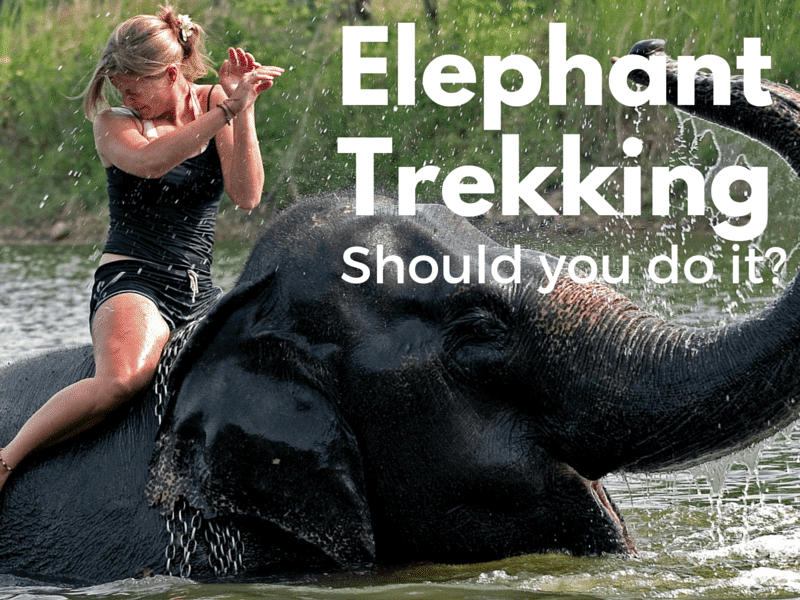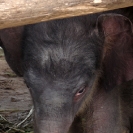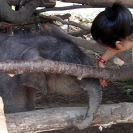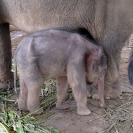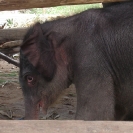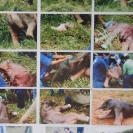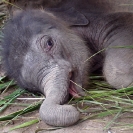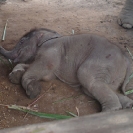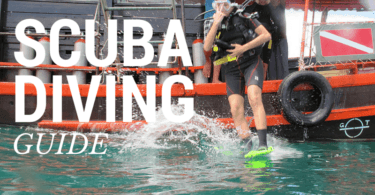Elephant Camps and Elephant Trekking on Koh Chang
Should you ride an elephant on holiday?
That’s a decision only you can make. I’ve been on elephant treks, on Koh Chang and elsewhere in Thailand but I wouldn’t do it again.
In an ideal world, there wouldn’t be any elephant camps on Koh Chang. But visitors would be able to see either wild elephants in the jungle or there would be a place similar to Elephant Nature Park, where you could get up close with the animals without riding them.
In reality, there are no indigenous elephants on Koh Chang. And it would be impossible, without a super rich benefactor, to buy or rent the amount of land required for an elephant sanctuary. Yes, it would be great for everyone to boycott all elephant camps. But that’s not a real solution.
If no one visits elephant camps you end up with a lot of starving elephants. And you can’t simply release an elephant born and reared in captivity into the wild. They live in close knit family groups. So there’s still the issue of where would all the elephants go and who would pay to look after them for the remainder of their lives. ( They have a similar lifespan to humans.)
So, if you want to see an elephant – which a lot of people do as they are beautiful creatures to observe – go to one of the elephant camps on the island. You don’t have to ride one. Buy some food and feed them.
Where Are The Elephant Camps?
There are, as of 2025, four elephant camps on Koh Chang. Two are located in the Klong Prao area, by the roadside, one is in Kai Bae and one is in the north of Koh Chang, 2 kilometres down an inland valley. All offer the same two types types of trek at the same price. So the choice of camp is more down to how far you want to travel to see the elephants and also how much you want to see them in an environment well away from the main road.
For most visitors to Koh Chang the camps in Klong Prao & Kai Bae will be located closer to their hotel and so are within easier reach. However, anyone making the effort to visit ‘Baan Kwan Chang’ in Klong Son valley will be rewarded by seeing the elephants in a more natural surroundings. Here the camp is in the jungle and surrounded by fruit farms and jungle clad hillsides, there is far less development – in contrast with the more built up roadside area in Klong Prao.
Elephant Welfare
If you’re into elephant welfare it’s worth mentioning that one of the camps was raided in 2013 by police from the Natural Resources and Environmental Crime Suppression Division for having illegal young elephants. ( Story here )
It’s always a bit dodgy if a camp has baby elephants that weren’t born there. Don’t believe any of the ‘poor little orphan elephant’ stories you might hear. During covid Elephant Nature Park rescued two elephants that the owner of the same camp no longer wanted to have to pay to look after.
And in April 2025 a bull elephant, from the same camp, got free and went on a mini-rampage in front of shocked holidaymakers. A couple of people were injured, a car and a couple of motorbikes damaged and a brick wall knocked down.
Also in August 2025 Boon Lott’s elephant reserve based in Sukhothai rescued two elephants from an elephant camp in Klong Prao. The initial plan was to raise funds to buy one elderly elephant. However, rescuers quickly realised that this elephant relied on a longtime friend and moving just one of them would cause a great deal of distress to the other. With that in mind over 2 million Baht was raised online in order to pay for their freedom. ( Story on their Facebook )
What About ‘The Crush’?
And if you are against the abuse of animals then you’ve probably already seen the videos and read stories of how young elephant calves are forced into submission using ‘The crush‘ in order for them to obey their human masters. That’s usually the first argument used against keeping captive elephants.
So, does that happen on Koh Chang? No. And there’s a good reason for that.
If you take a wild elephant calf from it’s mother then of course it’s going to want to fight back and will do everything it can to break free and find it’s herd. It would be like trying to train a wolf cub that you found roaming in a forest to behave like a household pet.
But if you have an elephant born into captivity, to a mother that has lived in captivity for all or most of her life and who’s been used to human contact since the day it was born, then training it is much easier. It’s more like training your family’s new puppy than a wolf cub.
Are the elephants mistreated on Koh Chang?
No more so than anywhere else. They are chained up as it isn’t safe to have large animals wandering around. And the mahouts will use a metal bullhook, also called an ‘ankus’, to keep the elephant focused on where it is going. If it is used correctly then it’s the same effect as using a choke chain on a dog, a short quick action to get it’s attention. Unfortunately, this doesn’t always happen.
Would it be better if the elephants were in the wild?
Yes. Of course.
But that’s not going to happen until everyone stops going to elephant camps. There isn’t a simple solution whereby the animals can all be moved to sanctuaries or rehabilitated into the wild. That requires a lot of money. Unfortunately, most of the organizations who shout for releasing elephants from camps fail to offer viable alternatives.
It can be done, as the success of Elephant Nature Park shows. But requires a lot of resources in terms of land and ongoing financial support to do so. That’s the had part.
Should you ride an elephant on holiday?
No.
If you ignore the captive vs. wild argument and just focus on the health of the elephant then you shouldn’t ride elephants as their spines aren’t designed to take a lot of weight. Sure, they are strong and can pull a car and lift huge logs with their trunks. But their backs aren’t designed for having weight pushing down on them.
Elephants Born on Koh Chang
There haven’t been many elephants born on Koh Chang. But Baan Chang Thai Elephant Camp in Klong Prao had three calves born within the space of 11 days in August 2007. Visiting the camp and playing with the 2-3 week old baby elephants was great fun. Also very interesting to watch the interaction between a new mother and her offspring. Some photos that I took below.
And on 12 June 2015, there was another new arrival at the same camp. An elephant calf, weighing in at around 70Kg, was born to ‘Som-O’ a 19 year old elephant. The gestation period for an elephant is around 22 months. The video of the birth is below . . . one big push and out it pops . . .
Which Elephant Camp to Visit?
If you just want to fee elepahnts then there are two or three tried up roadside opposite Annika Resort, Klong Prao. Pay 50 Baht for a small basket of fruit and you can feed them and take photos.
A nicer place to visit is ‘Klong Son Elephant Camp‘ (formerly ‘Baan Kwan Chang’ ), located deep in Klong Son valley.
Baan Kwan Chang was the first elephant camp on Koh Chang. The owner could have built it anywhere on the island but instead of locating it close to the main beach areas, he made the conscious decision to locate it away from development, with the idea of bringing the people to the elephants. Rather than having the elephants live in a busier area. Access to the camp was originally by a 3km dirt track , although that has now been paved.
It’s not perfect, they still offer elephant rides. But it is as goods as it gets on the island. Check out the Klong Son Elephant Camp Facebook page for more videos of the elephants and mahout life.
Elephant Trekking Prices
The other camps all make money solely from trekking. The prices are the same at all camps. 850 Baht/person for ah hour long short trek, 1,300 Baht/person for a longer trek with some elephant bathing thrown in. Treks usually run four times daily at all the camps – 09:00 / 11:00/ 13:00 / 15:00. Early morning will usually be cooler and quieter.
Children under around 12 years old (or if they are just very short) are half price. These prices include transport to/from your hotel, drinking water, fruit for you and the elephant.
Book through your hotel or any tour agent or just turn up at the camp. However, in high season, if you haven’t booked in advance you may have to wait for a ride. But remember that most hotels / agents will only deal with one of the camps and so if you want to visit a specific camp, you’ll need to shop around.


